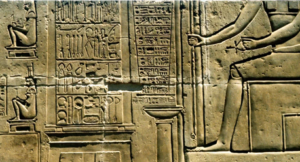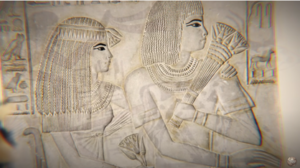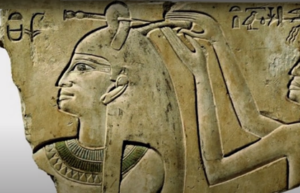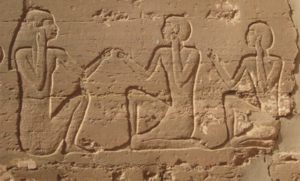-

Cardiac/Cardiothoracic (4)
The ancient Egyptians believed that when the connection between heart and specific organ is disrupted, the result is disease. As an example, how to treat specific vein disorders. If there are snake-like shapes filled with air all over the limbs, there "is an enemy of the vessel." Another description characterizes the oldest definition of arterial aneurysm, with instructions stating that a swelling vessel needs to be treated with a knife heated in fire. Other solutions are very simple, such as the one for dryness in the heart: If "he sighs often and his Heart is eaten up with anger; this is because his Heart is full of Blood, which in turn is due to drinking Warm Water and eating Bad Food." For diseases like this, a combination of honey, milk, and water is recommended. -

Common Injuries (3)
Injuries in Ancient Egypt were fractures: many were to the upper arms and fibula (bone in the lower leg). Most healed were good realignments to the bone, indicating they had been set with a splint. Injuries to the head are particularly interesting as, whilst they may be accidentally caused, they are often the result of intentional violence. “Long bone injuries are frequently seen in ancient Egyptian bodies and are more likely to be the result of an accident. Injuries to the femur (upper leg bone) occurred quite commonly; whilst the relatively lower number of tibia (shin bone) fractures is thought to be caused by going barefoot, especially among agricultural workers. Fractures to the arms are interesting, as they may be the result of an accidental fall or, as has been suggested for some Nubian injuries, may be the result of using the arms defensively to ward off violent blows to the head.” -

Cool Aid (17)
During 1500-1000 B.C., Egyptian hieroglyphics suggest they use glue made with animal derived adhesives for bonding and laminating. They first used to wrap their dead more than 6000 years ago, about a thousand years before the first pharaohs rose to power. In general, the bandages used to wrap a mummy were torn from old old linen sheets. -

Cool Aid with Dressing Pad (2)
The Ancient Egyptians custom of “coating” bandages with hashish is still used today in many villages. They also went overboard when applying bandages in the treatment of physical trauma. Being largely ignorant of medicine, they tended to simply bandage the entire body and hope for the best. -

General/Misc (4)
The "first physician", later deified as a god of medicine and healing, was the architect Imhotep (c. 2667-2600 BCE) best known for designing the Step Pyramid of Djoser at Saqqara. Imhotep is also remembered for initiating "secular medicine" through his treatises arguing that disease occurred naturally and was not a punishment from the gods. This ancient text is the oldest known written manual of surgery and trauma and describes 48 cases of wounds, fractures, dislocations, and tumours. Among the treatments described are suturing of wounds, splinting, bandaging, managing infections with honey and resins and the use of raw meat for the purpose of haemostasis. Immobilisation was advised for lower limb fractures and spinal cord injuries and it also describes reasonably detailed anatomical and physiological descriptions. Imhotep is thought to have diagnosed and treated over 200 diseases in his lifetime including tuberculosis, appendicitis, gout, gallstones, and arthritis. He also performed surgery and he may have also founded the first ever school of Medicine in Memphis. -

Hair Transplant (9)
Baldness was looked down upon. Chopped lettuce and ground-up hedgehog spines were applied to the scalp as a remedy for baldness. Egyptians have tried everything from camel dung to bear grease to achieve the same result. A male body from a working class cemetery in Hierakonpolis dated around 3500 B.C. had a sheepskin toupee used to hide a bald spot -

Neurosurgery (1)
In the realm of neurosurgery, ancient Egyptians were the first to elucidate cerebral and cranial anatomy, the first to describe evidence for the role of the spinal cord in the transmission of information from the brain to the extremities, and the first to invent surgical techniques such as trepanning and stitching. -

Oncology (7)
Some of the earliest evidence of cancer is found among fossilized bone tumors, human mummies in ancient Egypt, and ancient manuscripts. Growths suggestive of the bone cancer called osteosarcoma have been seen in mummies. Bony skull destruction as seen in cancer of the head and neck has been found, too. They found no indication ancient Egyptians had any specific treatment for cancer. -

Ophthalmology (2)
Congenital or disease-related blindness was viewed as a punishment from God. As a result of his impairment, a guy would drown in doubt and darkness. People utilized drops and ointments, which were thought to ward off various insects and demons that threatened with eye illnesses, to keep the eyes from becoming blind. The green chrysocolla and the black kohl cosmetics were carried by Egyptian eye doctors or physicians and were highly valued as prophylactic because they embodied Osiris' humours or bodily fluids. These goods were presented to the gods in order to revive their radiance and encourage the sun and moon to disperse their benevolent light. -

Oral (2)
The diet of the average ancient Egyptian was not exactly conducive to a great set of teeth. The tools used to grind food often left behind traces of sand and stone, which are naturally abrasive, and this often-meant tooth loss at an early age. The ancient Egyptians did employ some remedies for dental ailments, but they were somewhat bizarre and painful - for example, according to the Ebers Papyrus, the treatment for a toothache was rubbing a powdered mixture of onion, cumin, and incense on a tooth. There are cases where the ancient Egyptians filled cavities with a mix of resin and a greenish mineral that contained copper, and drilled into jawbones to drain abscesses of fluid, but curiously, the process of tooth extraction (often lifesaving in cases of infection) was almost never used -

Orthopedic (29)
Invasive surgery was simply not done in ancient Egypt. The lack of anesthesia and antiseptic made it essentially impossible as it would have resulted in excruciating pain and almost certain death from infection. However, the ancient Egyptians were quite adept at topical remedies. With the use of wooden splints and linens, they had a functional knowledge of how to set broken bones and correct dislocations. They also knew to stitch wounds and made effective herbal ointments to heal burns. -

Pediatric (2)
Evidence of appendicitis in children exists from ancient Egyptian mummies but the appendix was not discovered as an anatomical entity until the renaissance in Western European literature. Much confusion reigned over the cause of right iliac fossa inflammatory disease until the late 19th century, when the appendix was recognized as the cause of the great majority of cases -

Reconstructive (29)
Plastic surgery is at least as old as Ancient Egypt, predating things like anaesthesia and antiseptics by several millennia. The reconstructive efforts of the ancient Egyptians ring true of rhinoplasty, is generally considered to contain the earliest known of plastic surgery. -

Sports Medicine (8)
Many of today's sports were practiced by the Ancient Egyptians, who set the rules and regulations for them. Inscriptions on monuments indicate that they practiced wrestling, weightlifting, long jump, swimming, rowing, shooting, fishing and athletics, as well as various kinds of ball games.They certainly treated fractures of various kinds, and with varying degrees of success. Concerning the reductions of dislocated joints and therapeutic amputations, there is no clear evidence for the existence of such procedures. It would be surprising if dislocations were not treated, even though they have not left traces in the surviving sources. Concerning amputations, the general level of Egyptian surgery makes it unlikely that limb amputations were done, even if they may possibly have been performed under extraordinary circumstances. -

Wraps, Straps and Bands (WSB) (7)
This is the actual mummy linen bandage used from the late King Tutankhamun's Embalming Cache, ca. 1336-1327 B.C. that was excavated in 1907. The ancient Egyptians were no strangers to linen bandages, which they first used to wrap their dead more than 6000 years ago, about a thousand years before the first pharaohs rose to power. Once the embalming process was finished, the body was dried out the body with salt. After that, the mummies needed and extra layer of protection. This is where linen came in.
